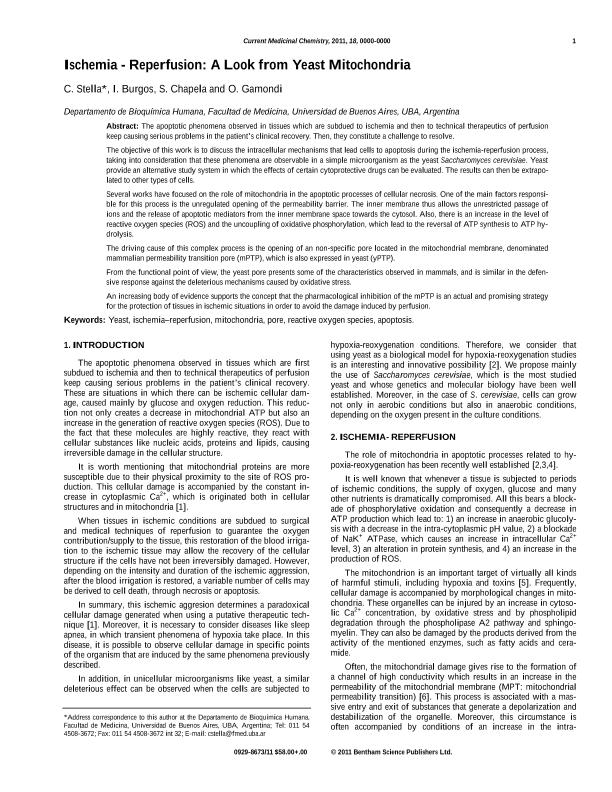Mostrar el registro sencillo del ítem
dc.contributor.author
Stella, Carlos Alberto

dc.contributor.author
Burgos, Hilda Isabel

dc.contributor.author
Chapela, Sebastián Pablo

dc.contributor.author
Gamondi, Oliver
dc.date.available
2020-09-07T20:06:38Z
dc.date.issued
2011-08
dc.identifier.citation
Stella, Carlos Alberto; Burgos, Hilda Isabel; Chapela, Sebastián Pablo; Gamondi, Oliver; Ischemia - Reperfusion: A look from yeast mitochondria; Bentham Science Publishers; Current Medicinal Chemistry; 18; 23; 8-2011; 3476-3484
dc.identifier.issn
0929-8673
dc.identifier.uri
http://hdl.handle.net/11336/113389
dc.description.abstract
The apoptotic phenomena observed in tissues which are subdued to ischemia and then to technical therapeutics of perfusion keep causing serious problems in the patient´s clinical recovery. Then, they constitute a challenge to resolve. The objective of this work is to discuss the intracellular mechanisms that lead cells to apoptosis during the ischemia-reperfusion process, taking into consideration that these phenomena are observable in a simple microorganism as the yeast Saccharomyces cerevisiae. Yeast provide an alternative study system in which the effects of certain cytoprotective drugs can be evaluated. The results can then be extrapolated to other types of cells. Several works have focused on the role of mitochondria in the apoptotic processes of cellular necrosis. One of the main factors responsible for this process is the unregulated opening of the permeability barrier. The inner membrane thus allows the unrestricted passage of ions and the release of apoptotic mediators from the inner membrane space towards the cytosol. Also, there is an increase in the level of reactive oxygen species (ROS) and the uncoupling of oxidative phosphorylation, which lead to the reversal of ATP synthesis to ATP hydrolysis. The driving cause of this complex process is the opening of an non-specific pore located in the mitochondrial membrane, denominated mammalian permeability transition pore (mPTP), which is also expressed in yeast (yPTP). From the functional point of view, the yeast pore presents some of the characteristics observed in mammals, and is similar in the defensive response against the deleterious mechanisms caused by oxidative stress. An increasing body of evidence supports the concept that the pharmacological inhibition of the mPTP is an actual and promising strategy for the protection of tissues in ischemic situations in order to avoid the damage induced by perfusion.
dc.format
application/pdf
dc.language.iso
eng
dc.publisher
Bentham Science Publishers

dc.rights
info:eu-repo/semantics/openAccess
dc.rights.uri
https://creativecommons.org/licenses/by-nc-sa/2.5/ar/
dc.subject
APOPTOSIS
dc.subject
ISCHEMIA-REPERFUSION
dc.subject
MITOCHONDRIA
dc.subject
PORE
dc.subject
REACTIVE OXYGEN SPECIES
dc.subject
YEAST
dc.subject.classification
Otras Medicina Básica

dc.subject.classification
Medicina Básica

dc.subject.classification
CIENCIAS MÉDICAS Y DE LA SALUD

dc.title
Ischemia - Reperfusion: A look from yeast mitochondria
dc.type
info:eu-repo/semantics/article
dc.type
info:ar-repo/semantics/artículo
dc.type
info:eu-repo/semantics/publishedVersion
dc.date.updated
2020-05-11T15:44:51Z
dc.identifier.eissn
1875-533X
dc.journal.volume
18
dc.journal.number
23
dc.journal.pagination
3476-3484
dc.journal.pais
Estados Unidos

dc.description.fil
Fil: Stella, Carlos Alberto. Universidad de Buenos Aires. Facultad de Medicina; Argentina. Consejo Nacional de Investigaciones Científicas y Técnicas. Oficina de Coordinación Administrativa Houssay. Instituto de Investigaciones Biomédicas. Universidad de Buenos Aires. Facultad de Medicina. Instituto de Investigaciones Biomédicas; Argentina
dc.description.fil
Fil: Burgos, Hilda Isabel. Universidad de Buenos Aires. Facultad de Medicina; Argentina. Consejo Nacional de Investigaciones Científicas y Técnicas. Oficina de Coordinación Administrativa Houssay. Instituto de Investigaciones Biomédicas. Universidad de Buenos Aires. Facultad de Medicina. Instituto de Investigaciones Biomédicas; Argentina
dc.description.fil
Fil: Chapela, Sebastián Pablo. Universidad de Buenos Aires. Facultad de Medicina; Argentina. Consejo Nacional de Investigaciones Científicas y Técnicas; Argentina
dc.description.fil
Fil: Gamondi, Oliver. Universidad de Buenos Aires. Facultad de Medicina; Argentina
dc.journal.title
Current Medicinal Chemistry

dc.relation.alternativeid
info:eu-repo/semantics/altIdentifier/doi/http://dx.doi.org/10.2174/092986711796642553
dc.relation.alternativeid
info:eu-repo/semantics/altIdentifier/url/https://www.eurekaselect.com/74757/article
Archivos asociados
